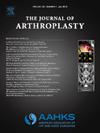原发性骨肉瘤切除术后进行股骨远端或胫骨近端置换术的患者定期恢复中度和低度冲击类型的体育活动。
IF 3.4
2区 医学
Q1 ORTHOPEDICS
引用次数: 0
摘要
背景:人们对骨肉瘤切除术后股骨远端和胫骨近端巨型假体重建后恢复体育活动的情况知之甚少。因此,我们的研究目的是(1)评估功能结果;(2)评估术前和术后进行的体育活动;(3)确定潜在的有利因素和限制因素:1993年至2015年间,共有230名患者接受了股骨远端置换术(DFR),96名患者接受了胫骨近端置换术(PTR)。排除标准为死亡、截肢、居住在海外以及先天性残疾。采用肌肉骨骼肿瘤协会评分(MSTS)、多伦多肢体救治评分(TESS)、遗忘关节评分(FJS)、主观膝关节值(SKV)、Tegner活动评分(TS)和改良加权活动评分(WAS)对患者的功能结果和运动情况进行评估:93名患者在DFR术后的中位随访时间为182个月(四分位间距(IQR)为130至260),中位评分如下:MSTS 18 (IQR 12 至 23)、TESS 75% (IQR 60 至 84)、FJS 25 (IQR 8 至 40)、SKV 53% (IQR 40 至 70)、TS 3 (IQR 3 至 4) 和 WAS 4 (IQR 0 至 8)。有 42 名患者在 PTR 后的中位随访时间为 193 个月(IQR 137 至 244),中位评分如下:MSTS 17 (IQR 15 至 22)、TESS 78% (IQR 68 至 88)、FJS 32 (IQR 20 至 46)、SKV 60% (IQR 40 至 70)、TS 3 (IQR 3 至 4) 和 WAS 4 (IQR 1 至 10)。术后,61% 的 DFR 和 76% 的 PTR 患者参加了至少一项体育活动:结论:患者的功能恢复情况总体良好,可以定期恢复体育活动。患者手术时的年龄和术前较高的运动水平与较好的功能预后和较高的术后运动量有关。本文章由计算机程序翻译,如有差异,请以英文原文为准。
Patients Regularly Return to Medium- and Low-Impact Types of Sporting Activities Following Distal Femoral or Proximal Tibial Replacement After Resection of a Primary Bone Sarcoma
Background
Little is known about the resumption of sporting activities following megaprosthetic reconstruction of the distal femur and proximal tibia after resection of a bone sarcoma. Thus, the aims of our study were: (1) to assess the functional outcome; (2) to evaluate pre- and post-operatively performed sporting activities; and (3) to identify potential beneficial and limiting factors.
Methods
Between 1993 and 2015, a total of 230 patients underwent distal femoral replacement (DFR), and 96 patients underwent proximal tibial replacement (PTR). The exclusion criteria were death, amputation, living overseas, and a congenital disability. Functional outcome and sporting activities were assessed using the Musculoskeletal Tumor Society Score (MSTS), Toronto Extremity Salvage Score (TESS), Forgotten Joint Score (FJS), subjective knee value (SKV), the Tegner activity score (TS), and the modified weighted activity score (WAS).
Results
There were 93 patients who had a median follow-up of 182 months (interquartile range (IQR) 130 to 260) after DFR with the following median scores: MSTS 18 (IQR 12 to 23), TESS 75% (IQR 60 to 84), FJS 25 (IQR 8 to 40), SKV 53% (IQR 40 to 70), TS 3 (IQR 3 to 4), and WAS 4 (IQR 0 to 8). There were 42 patients who had a median follow-up of 193 months (IQR 137 to 244) after PTR had the following median scores: MSTS 17 (IQR 15 to 22), TESS 78% (IQR 68 to 88), FJS 32 (IQR 20 to 46), SKV 60% (IQR 40 to 70), TS 3 (IQR 3 to 4), and WAS 4 (IQR 1 to 10). Postoperatively, 61% of DFR and 76% of PTR patients participated in at least one sporting activity.
Conclusions
The functional outcome is overall good with a regular resumption of sporting activities. Patients’ age at surgery and higher preoperative sporting levels were associated with better functional outcomes and higher postoperative sporting activity.
求助全文
通过发布文献求助,成功后即可免费获取论文全文。
去求助
来源期刊

Journal of Arthroplasty
医学-整形外科
CiteScore
7.00
自引率
20.00%
发文量
734
审稿时长
48 days
期刊介绍:
The Journal of Arthroplasty brings together the clinical and scientific foundations for joint replacement. This peer-reviewed journal publishes original research and manuscripts of the highest quality from all areas relating to joint replacement or the treatment of its complications, including those dealing with clinical series and experience, prosthetic design, biomechanics, biomaterials, metallurgy, biologic response to arthroplasty materials in vivo and in vitro.
 求助内容:
求助内容: 应助结果提醒方式:
应助结果提醒方式:


